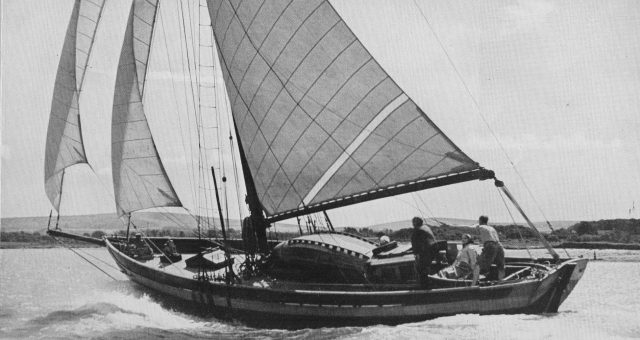
SUMMER NEWSLETTER JUNE 2023
This Newsletter seems to be taking on a somewhat retrospective feeling, responding as they all do to the material that you kind Vertue enthusiasts contribute. This time there is also a certain amount of input from ‘the archives’ and it is from there that this wonderful photograph of the magnificent Dyarchy, taken by Eric Hiscock, has been resurrected.
Before coming to this, the latest of the occasional episodes of the Vertue Design Dynasty story, we are also really delighted to be able to put into print the first part of an insightful account of Bill Nance’s incredible high latitude circumnavigation aboard Cardinal Vertue in the mid 1960’s.
Occasional visitors to our modest website might not yet have noticed that we have a new Section highlighting those Vertues that are currently For Sale. Every Vertue is different from her sisters, and these three are all very special in their own way. As you can read later on, the first Vertue to double Cape Horn was followed 20 years later by Sparrow, and we are proud to feature her here. She is in absolutely fantastic condition, almost ready to go again! A near sister-ship to Cardinal Vertue V19, also built in 1948, is For Sale here in Devon. Serif V 28 is the only Vertue built by Cardnells in Maylandsea, Essex, and was lovingly crafted of beautiful materials. Another outstanding example of the class moored locally, Vertue Fidelis V40, was famously built for the 1951 Festival of Britain as an outstanding example of British craftsmanship.
We now have some good news from ‘Down under’ about the rescue of a lovely, little known Vertue, which was named after a famous clipper ship.
____________________
In recent Newsletters we have sadly had to report on the final demise of both Blue Jenny in the US and Eleanor of Poole in Wales. In contrast I’m now delighted to introduce a ‘new’ Vertue called Punjab into our midst, and she is actually being refitted in Melbourne, Australia.
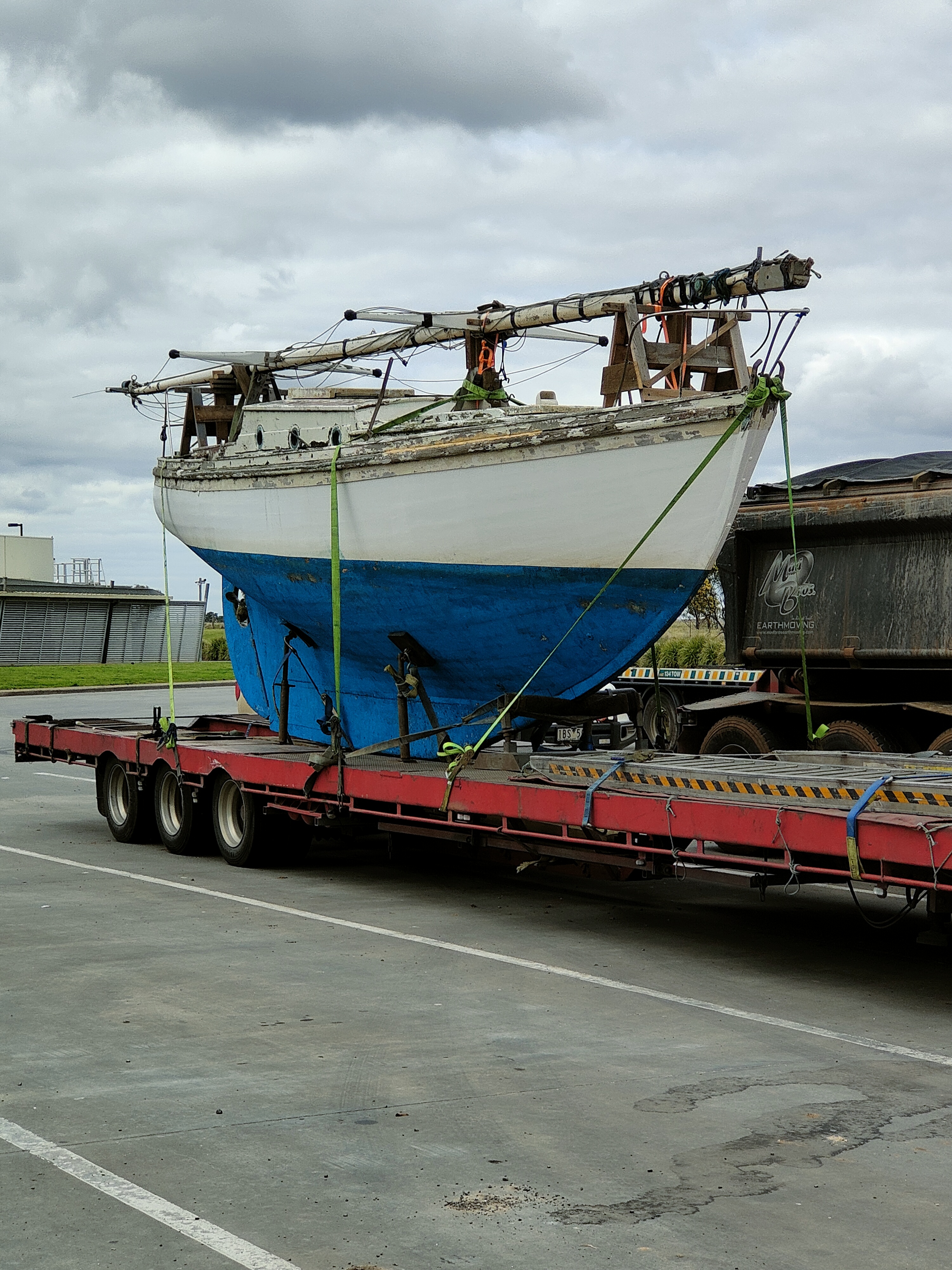
Punjab being rescued
As you can see, Punjab has an unusual coachroof configuration which is a cross between the ‘ocean’ boats with their long, after part, usually with four portlights, and some of the other Australian Vertues, with almost a doghouse arrangement and two large portlights. This looks very nicely proportioned indeed to my eye, and is very similar to Sunbeam, V 155,which was built much later.


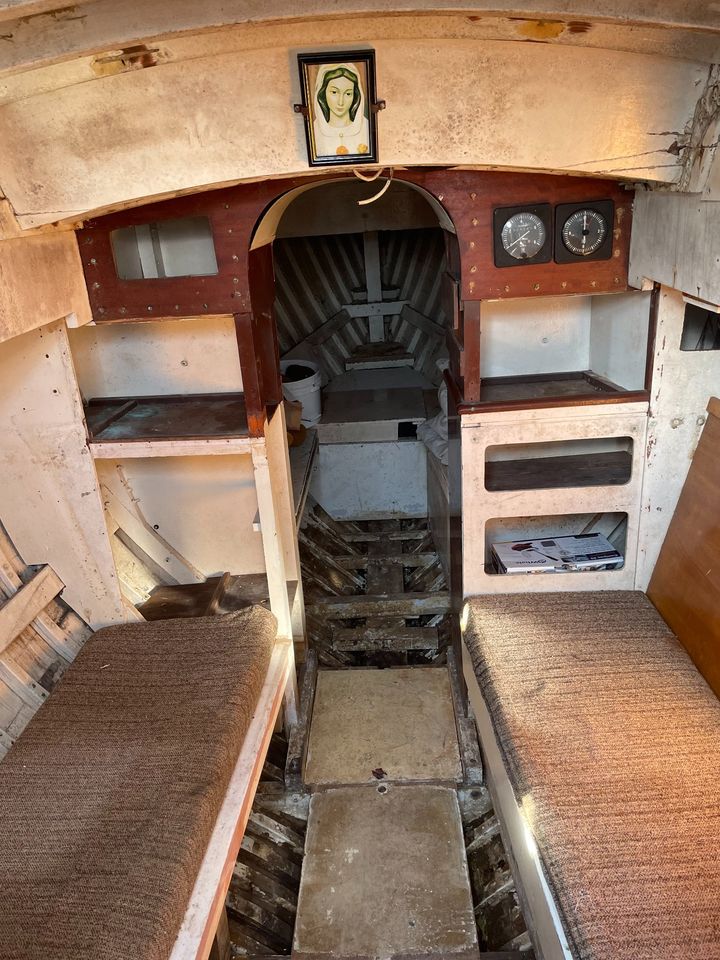
Punjab has clearly been sadly neglected but her new owner, Nick Trethowan, is planning to give her a proper refit in his back garden, where she is already installed. Her name derives from the clipper ship Punjaub, teak built in Bombay in the mid C19 for the Austalian trade. We hope to be able to report on progress in future Newsletters.
____________________
AROUND THE WORLD SINGLE-HANDED: Part 1
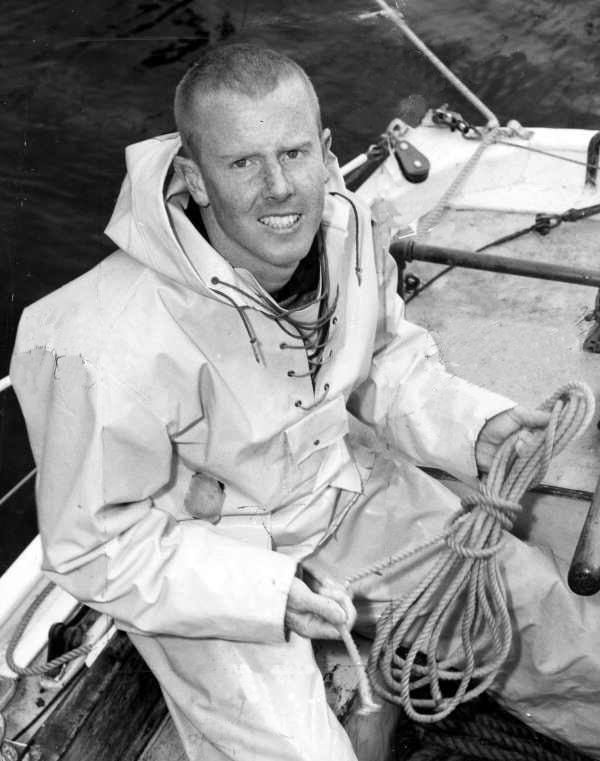
Bill Nance aboard Cardinal Vertue in Australia in 1963
This story has been put together by Paul Zeusche after many weeks of patient work, listening to Bill’s memories of how he came to go to sea, and how he ended up doubling Cape Horn, single-handed, in his 25′ long Vertue. Paul is a very old friend and business partner and lives not far away from Bill on Puget Sound.
Introduction
Passages round Cape Horn aboard small yachts were pretty rare before the mid-1960’s. Bill Nance’s remarkable voyage with Cardinal Vertue is believed to have been only the third single-handed doubling of The Horn aboard a small boat and most certainly the first by a lone Australian sailor. He was only preceded by the Norwegian, Alfon Hansen, aboard the Mary Jane in 1934, and Argentinian, Vito Dumas, with Lehg II, in 1943. Both of these were much larger boats. Then, later in the 1960’s, thanks to the single-handed ventures of Chichester, Rose, Knox-Johnston, and others, which were very well publicized by British newspapers to boost readership, everything changed. However, Cardinal Vertue remained the smallest vessel to double The Horn, single-handed during a circumnavigation until at least 1973.
As Bill is a quiet, unassuming fellow, this is the first really accurate account of his endeavours and was related to this writer and proof read by Bill himself, and wife Marie over a period of several weeks, hopefully correcting many small factual errors in 2nd hand accounts by others over the years. This account is as much about the small engineless Laurent Giles designed Cardinal Vertue as it is about her youthful and initially inexperienced Australian skipper, between the years 1962 and 1965.
The Skipper
Bill Nance was the first Australian to circumnavigate alone in an engineless small boat via the three great capes of Good Hope, Leeuwin and The Horn. Without sponsorship, fanfare, or cheering crowds, to witness his quiet departure from Brixham, Devon, England in mid-September 1962, the 24 year old skipper, with scant blue water experience and minimal navigation skills, departed, ultimately with a first landfall at Funchal on the Portuguese island of Madeira in the Atlantic en-route to Buenos Aires, Argentina. Learning to navigate whilst at sea, using Mary Blewitt’s book ‘Celestial Navigation for Yachtsmen’, and teaching himself to use a sextant, Nance’s first blue water passage was successful and completed without incident.
Bill Nance was born in the bush hospital at Yarra Junction, in the Yarra Valley, a rural community 35 miles east of the city of Melbourne in December 1937. The second child and oldest son of a South African father and an Australian mother, with five younger siblings to follow, Nance aged 18, like many antipodean kids, had the urge to venture overseas, often to former British colonies and the UK, colloquially known as the Great OE, or ‘Overseas Experience’. Passage was made aboard the diesel powered passenger ship Fairsea in 1956. She had been converted from an aircraft carrier and made regular return passages to England as part of the ‘assisted immigrant program’.
Being a keen cricketer, Bill had a ‘fantasy goal’ to find some way of working and playing cricket all the year round! Ideally this would be in England in the northern hemisphere summer and in South Africa in the southern hemisphere summer, where he had numerous relatives on his father’s side.
In pursuing that ambition an opportunity arose to move from England to South Africa through the recruiting efforts of the South African government embassy in London. He was offered a place in the government Miners Training School to undertake an 18 month paid practical training program in the Gold mining industry, with opportunities to secure work upon completion of the course.
At the conclusion of his training, Nance continued to work for 6 months in the mines of Stilfontein, where he had trained. There, in the western Transvaal, as a hard ‘rock miner’, working under extraordinarily challenging conditions over a mile underground, in excessive heat, blasting rock in the search for gold. The European recruits now armed with practical experience underground were in charge of clearing debris from the previous night’s blasting, and drilling to insert new explosive charges at the seam face. Nance was in charge of up to 100 men, mostly native labourers, all working in what now would be classed as dangerous and appalling conditions, up to 6,000 ft underground. Six months of this was enough, and a new job was sought, eventually finding a place in a mine in Northern Rhodesia, (now Zambia), and still deep underground. Although only about 3,000 feet deep, the work was somewhat similar, but a different type of operation, now mining for copper but still grueling and dangerous, with scant attention to health or safety.
The working week was 6 days and in his limited spare time Nance learnt to sail on the nearby lake. The Firefly dinghy class was produced by Fairey Marine on the Hamble River, Southampton, using the aircraft wood veneer, hot-molded manufacturing techniques developed by De Havilland during the war for the Mosquito bomber and other aircraft of the day.
After 5 years in Southern Africa, Nance left in September 1961 to return to the UK with the vague idea of sailing a boat of his own back to Australia. In an effort to expand his rudimentary nautical knowledge he found a crew position on a motorized barge owned by R&W Paul out of Ipswich, Suffolk, transporting grain from there to the London Docks. But upon seeing the Cambria, the last surviving coastal sailing barge, he jumped ship, so the speak. She was owned by the Everard Steamship Company, and at 95′-6” long and 109 tons she was usually crewed by a Skipper, Mate and a “boy” who could be any age. Before long the mate quit, leaving just the Skipper and Nance, the boy, to manage the large spritsail-rigged barge on their own! Typically, loading cargo in London, at the Royal Docks, she sailed down the river Thames to Ramsgate and then up the east coast of England, as far north as Great Yarmouth, usually returning empty to London.
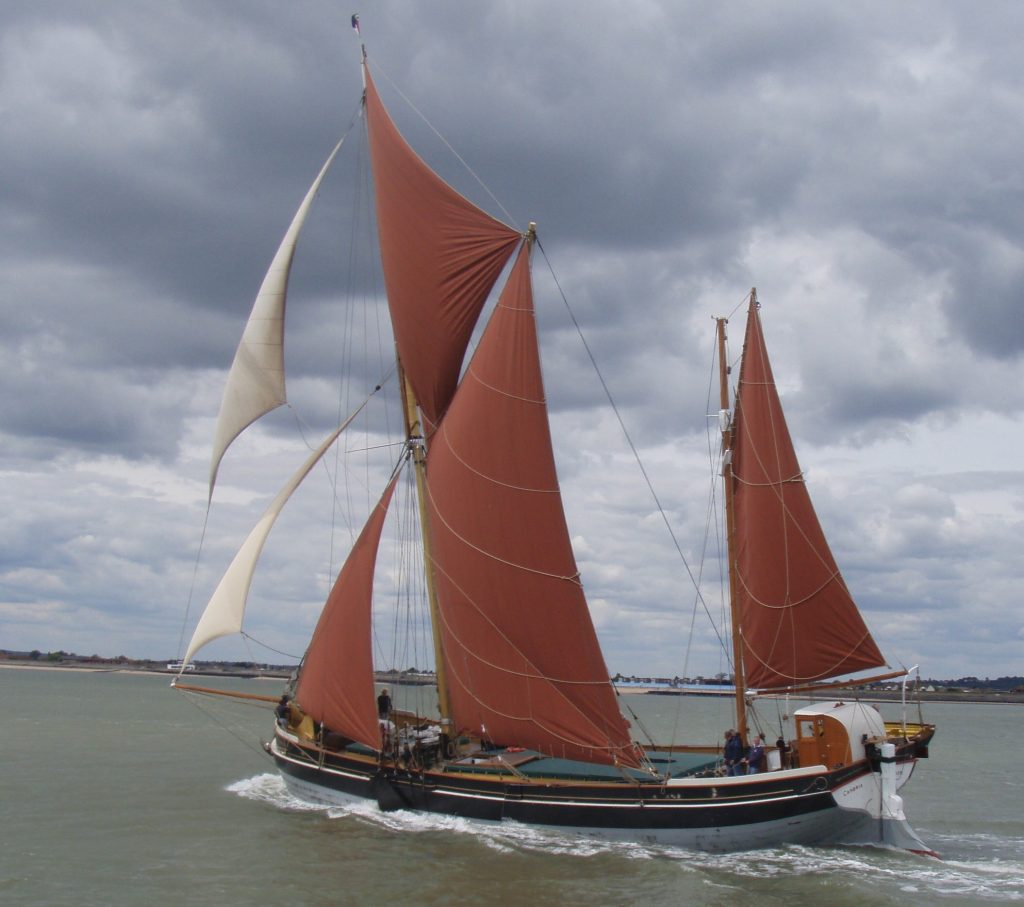
The Thames spritsail sailing barge Cambria today.
Her very experienced skipper was A.W. ‘Bob’ Roberts, who, after his retirement, variously became a British folk singer, songwriter, author, journalist and story teller. He had completed a couple of blue water passages, with a friend, in earlier days from London. One was through the Panama Canal to Cocos Island, where the vessel was wrecked after dragging her anchor during a sudden squall, ending up ashore; his adventures were recounted in the book, ‘Breeze for a Bargeman’.
Under Bob Robert’s tutelage, Bill Nance expanded his seagoing experience and, in the search for an affordable boat, was lucky to have Bob along for advice when eventually a suitable boat was found. Fortunately, Nance had Cardinal Vertue surveyed, which revealed serious electrolytic corrosion between her galvanized iron floors and copper bolts and through adjacent frames and planking. This was ultimately deemed repairable, and forced the sale price down, with the agreed repairs to be completed at Priors Yard in Burnham-on–Crouch. The problem also necessitated some lower plank replacement, amongst other structural defects.
Thus, Nance became the new and proud owner of Cardinal Vertue, owned at the time of sale by none other than ex-pat Kiwi, Dr. David Lewis, who had recently completed the inaugural 1960 Single Handed Transatlantic Race against 3 other competitors with relatively small boats, of around 25′; Francis Chichester, of course, had a much larger 40′ boat. Chichester arrived first in 40 days and David Lewis came third in 56 days, including having to return to Plymouth to repair his mast which broke at the upper spreaders, less than a day out! His return to the UK that autumn was an incredible feat of endurance as the boat was hit by gale after gale but Lewis was tough enough to cope, and arrived in the Shetland Islands almost 26 days out of St. Johns, Newfoundland. The following year he sailed the boat south and eventually sold her to Bill Nance in the summer of 1962.

Cardinal Vertue sailing in the first OSTAR skippered by Dr. David Lewis.
The Boat
This brings us to Cardinal Vertue, and the beginning of the rest of the story!
The original Vertue, Andrillot, was designed by Laurent Giles in 1935, as a gaff cutter. The design evolved over the years and by the late 1940’s, when Cardinal Vertue was built, had been developed to carry a double-spreader bermudan mast, stepped on the coach roof, with running and standing backstays. The short doghouse over the companionway completed her revised profile. Some had small motors, but many remained engineless and proved to be capable small boats for coastal cruising and as later found, with a very respectable turn of speed for such a short, 21’6”, waterline.
Cardinal Vertue was built in 1948 by Elkins, a long established and still extant yard in Christchurch, Dorset, for predominantly local cruising in the UK and remained in single ownership for 10 years until sold to Dr. Lewis. With the OSTAR in his sights, he replaced the single standing backstay to its boomkin with a pair of backstays to the quarters. This allowed space for the simple self-steering vane to rotate freely.
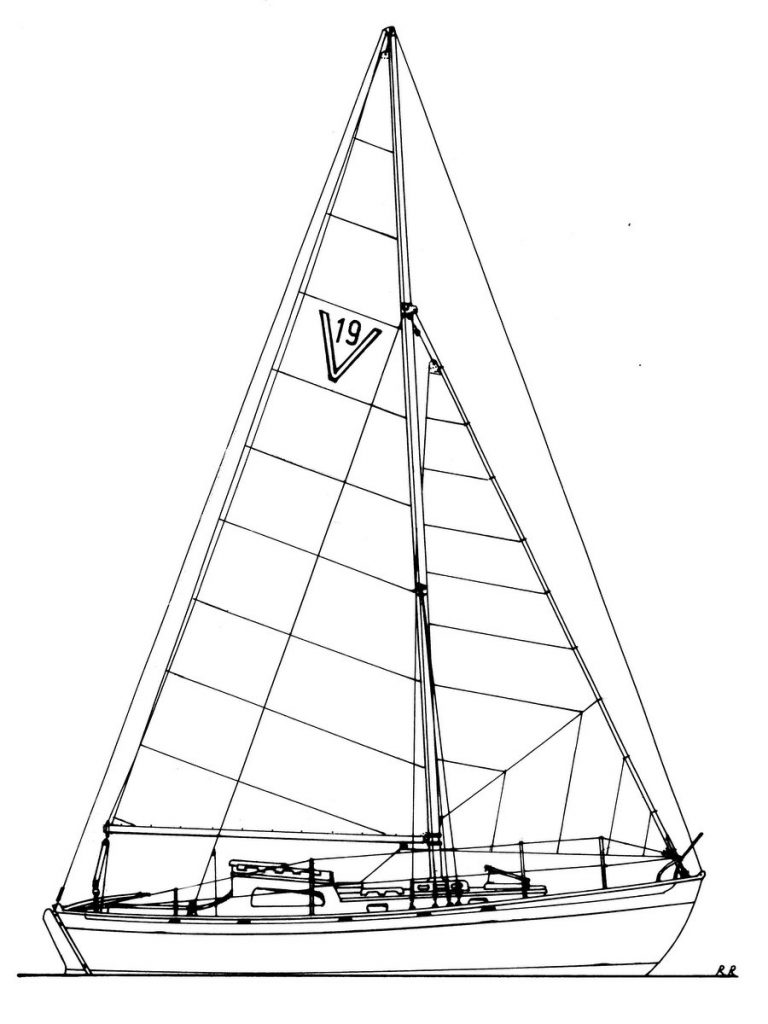
Sketch profile drawing of Cardinal Vertue.
More than two hundred Vertues, with several design variations, have actually been built over the years, and the majority are of conventional plank on frame, timber construction, with strip planked and glassed over hulls becoming available since the 1980’s. Most were built by British boatyards, but the Cheoy Lee Shipyard in Hong Kong were chosen to build over twenty boats over the years, largely because of the availability of good quality teak at a competitive price.
About forty grp Vertues were moulded by Bossoms, near Oxford, after several earlier hulls had been finished by different owners. One of these, the Sparrow, was completed by father and son team, Daniel and David Hays and sailed 17,000 miles around South America from their home on the northeast coast of the US. She became the second Vertue to double the Horn, almost 20 years to the day after Bill Nance.
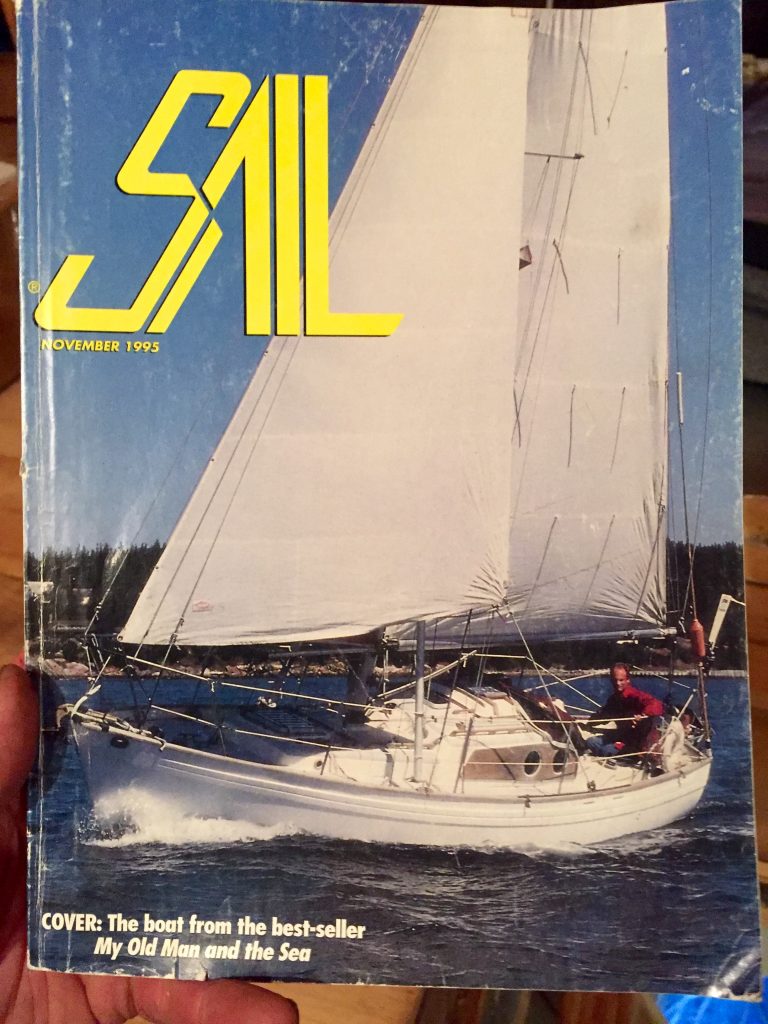
Sparrow doubled The Horn in 1985
An excellent and informative web site <http://www.vertueyachts.com> has much detail of the 250 or so, that are known to have been built, and is highly recommended for those interested. (thank you Paul!)
Many Vertues have completed remarkable ocean passages. One of the earliest was Humphrey Barton’s crossing of the north Atlantic from east to west aboard Vertue xxxv in 1950, with one other crew member. More than a dozen multi-ocean voyages over several years have followed, and long ocean passages have become quite common.
Back to the voyage.
Following the repairs being completed by Prior’s Yard, Bill removed the small Stuart Turner petrol engine, in order to accommodate more fresh water storage, and later in Cowes, Isle of Wight, installed additional storage lockers. Still with scant experience, he set sail on Cardinal Vertue, coastal hopping down the east coast of the England at the onset of autumn of 1962, which included a serious grounding in deteriorating weather in the Solent, fortunately without major damage, except perhaps to his nerves! However, he prudently put in to Cowes, and hauled out to check the integrity of the hull and complete other minor additions. Then he sailed on down the coast, anchoring in Weymouth Bay to sleep at night, before continuing on to Brixham, Devon.
This was just the start of a character building period, which would continue for quite a while, as he then anchored in Torbay, off Brixham Harbour, to avoid bad weather in the English Channel. Unwilling to enter the harbor under sail, Nance’s tethered dinghy broke loose during the stormy night, but was fortunately rescued by the crew of the cross-harbour ferry. Nance saw that his missing dingy was tied up in the inner harbour, so, next morning, he had no choice except to sail into the harbour and re-claim it!
Provisioning and preparation for departure had been largely completed in Cowes and on September 13th, 1962, Nance finally departed from Brixham, England for his first ocean passage, taking him across the Bay of Biscay. Keeping well away from the Portuguese coast, and out into the Atlantic to Funchal, capital of the Portuguese island of Madeira, he made his landfall on September 28th. 1962.
Navigation skills, as noted earlier, were acquired en route, using Mary Blewitt’s’ book, accompanied by Sight Reduction tables and a used sextant, purchased from a marine chandlery company in London. He also had a well-used surplus Royal Navy deck watch in lieu of an unaffordable (to Nance) chronometer. His inexpensive store-bought transistor radio, with Short Wave band, was capable of picking up the BBC time signals, enabling longitude positions to be calculated from his noon sights when weather allowed; not always easy on a small vessel at sea.
Minimal re-provisioning of fresh fruit and vegetables completed in Madeira, he departed Funchal 4 days later on October 2nd. 1962, Nance was fully prepared for the long passage down through the Atlantic to Buenos Aires, Argentina. As he had initially planned, he broke up the long ocean passage to Cape Town, South Africa, with a short stop in Buenos Aires. Meanwhile, leaks from the aging canvas covered deck were rapidly worsening as he sailed south.
Initially, anchoring in the large commercial Port of Buenos Aires flying the Q flag to request clearance he was ignored by the authorities, so a move was made to San Fernando some distance up the River Plate to the hospitable Argentine Yacht Club with repair facilities nearby. The deck covering was too far gone to save so, this was removed and replaced and Nance now could anticipate a dry berth for a change! The well-used secondhand Royal Navy deck watch, purchased in London was replaced by a regular wrist watch as it was not able to keep a consistent rate.
At this time, in the early 1960s, yacht passages from Europe to the South Atlantic were rare, so Nance had nothing to compare his 62 day, 4500 + passage time from Funchal to Buenos Aires including about 14 days through the Doldrums. The only comparisons were the old square-rigged sailing ships and Nance had to use the same British Admiralty Sailing directions as they did, because there was nothing else!
The self-steering on Cardinal Vertue, originally installed by Dr. Lewis, was not working reliably though it had served Lewis well enough on his two transatlantic passages. A local fellow at the Argentine Yacht Club claimed to have a better version of the gear, which Nance had installed, but it turned out to be no better than the original.
Now patched up and re provisioned, Nance took his departure for Cape Town, heading southeast, seeking the westerly winds, for an uneventful crossing of 39 days, and another 3000 mile passage. His navigation and passage making skills were rapidly improving, as he put the miles under the keel.
Bill had relatives on his father’s side in Cape Town, so several weeks were spent socializing as well as preparing for the long haul to Australia; he departed Cape Town March 21st. 1963, originally bound for his home town of Melbourne, however events overtook him, as we shall see, in the next Newsletter!
____________________
THE VERTUE DESIGN DYNASTY Part 4
During the 1920’s and ’30’s the debate about the superiority of working boats, such as pilot cutters, over yachts with lighter displacement, finer lines and bermudan rigs continued to rage. In the autumn of 1928 Jack Giles lifted the lines of the French Jolie Brise. A few years later, his friend Roger Pinkney also lifted the lines of the Hambly built, converted Bristol Channel pilot cutter Cariad, from Cardiff.
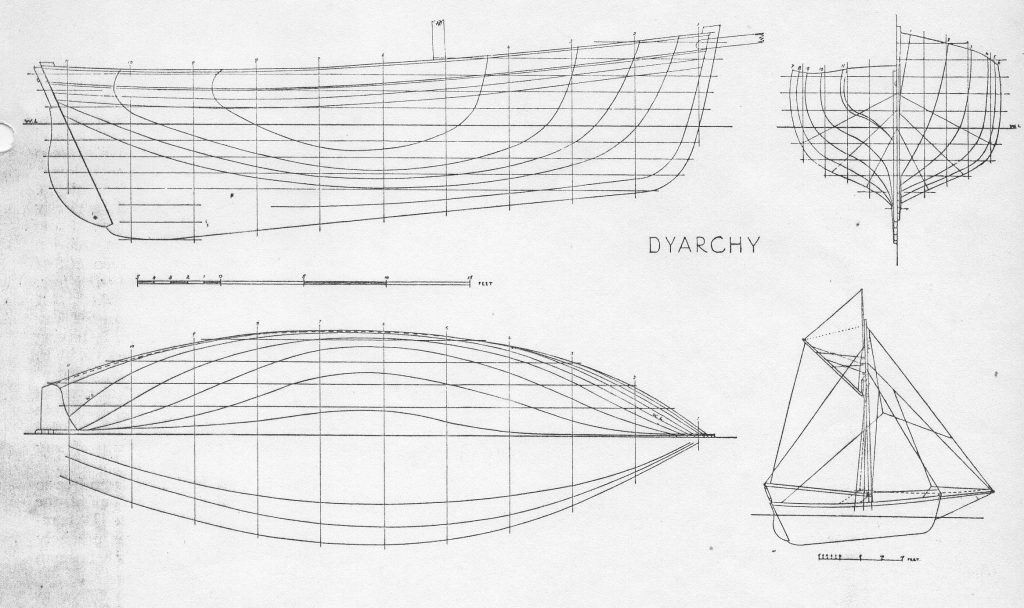
The old, transom-sterned converted pilot cutter Dyarchy
Roger Pinkney was a conservation architect and Vice Commodore of the RCC for several years during the 1930’s. Eric Hiscock dedicated his iconic ‘text book’, Cruising Under Sail to him, “who taught me and many others how to cruise without fuss”. Much of this ‘teaching’ took place aboard Roger’s own converted pilot cutter, the transom-sterned Dyarchy, built by Coopers in Pill, down the river from Bristol, in 1901.
By 1938 it was clear that the old Dyarchy was past her prime, and that perhaps she could be replaced by a more modern yacht. As we have seen in earlier Newsletters, Jack Giles had already designed a number of small cruising yachts with clear ‘pilot cutter’ like characteristics. These included Andrillot, Kalliste, Valfreya and Fairlight, as well as Eric’s own diminutive Wanderer II which was designed alongside Andrillot. Once again, the Swedish boatyard of the Truedsson family were chosen for the build, as they had made such a good job of Valfreya. Clearly, Roger Pinkney was a highly skilled and knowledgeable client, so perhaps it is not surprising that the resulting collaboration between him and Giles should result in such a sublime sailing yacht.

The new gaff cutter Dyarchy
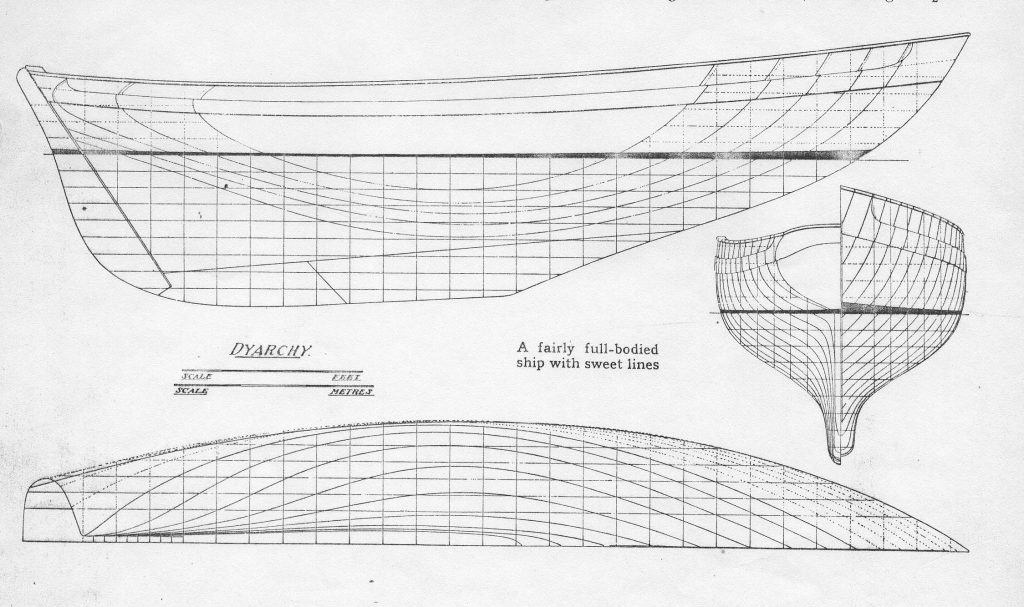
These exquisite lines show Dyarchy’s hull form. I cannot resist the chance to display them in greater detail. Compare them with those of Andrillot, and for sweetness with Jolie Brise. Perhaps that is what Giles learnt when he lifted the French boat’s lines a decade before.
Unfortunately, before Truedssons could finish fitting out Dyarchy, a German landlubber called Hitler put the civilised world on hold for five, long years, and she was carefully stored ashore in Sweden, well out of harm’s way.

Roger Pinkney had clear ideas about how proper seagoing accommodation should be fitted into a real cruising boat, as can be seen in these drawings. Eric Hiscock wrote endearingly about her and told how Roger was not averse to spending a weekend cruise aboard with just his 90 year old mother as ‘crew’. I suspect she probably sat at the tiller whilst he handled the gear with consummate skill! The combined talents of Jack Giles and Roger Pinkney created this enviable living space for the lucky crew who were to sail aboard one of the design icons of mid-C20 cruising yachts.
By the mid 1970’s Dyarchy had been passed on to the Batten family who completed a classic ‘Atlantic Circuit’ cruise in her, revelling in her performance. In preparation for this cruise, her varnished topsides were painted white. Her owner wrote “As every sailor seems to feel he has a proprietory interest in Dyarchy, we have to accept many comments on her change of colour.” In almost every other respect she remained unaltered since being commissioned in 1946.

Sorceress in New Zealand
It was inevitable that the design should be replicated. We were surprised and delighted to come across Sorceress when we attended the Marhurangi Classics regatta in New Zealand some years ago.
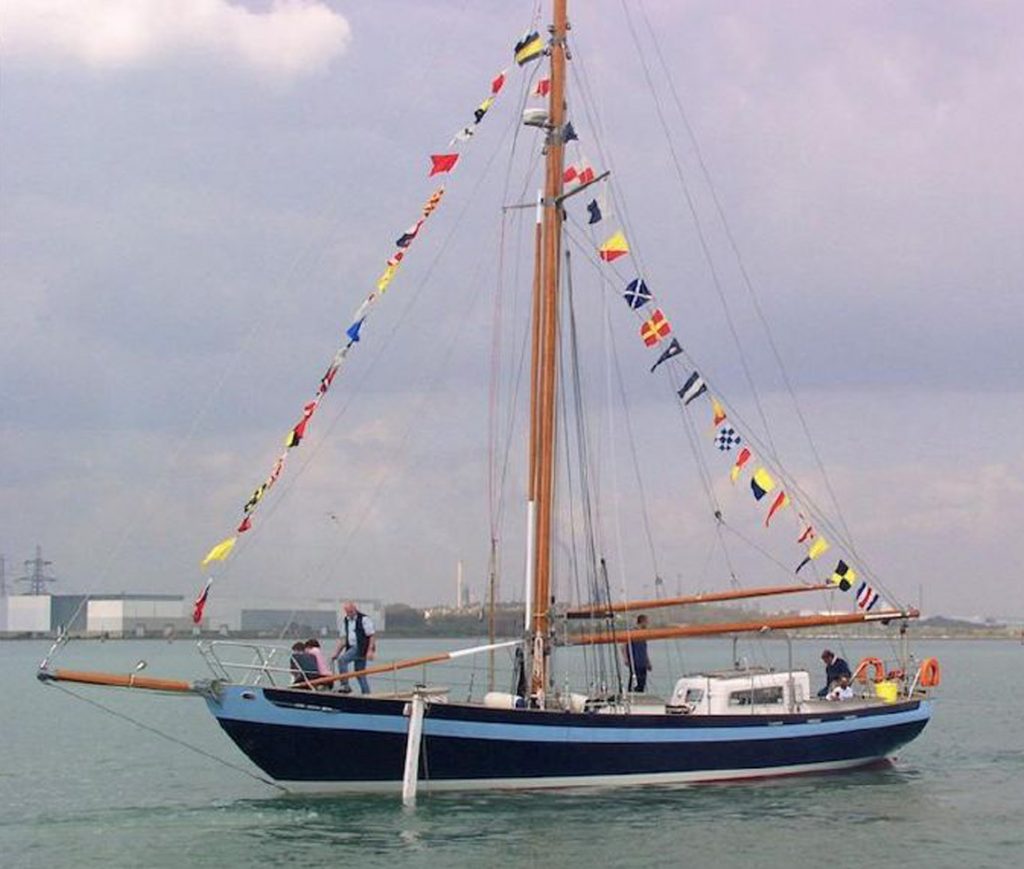
A steel version of Dyarchy being launched.
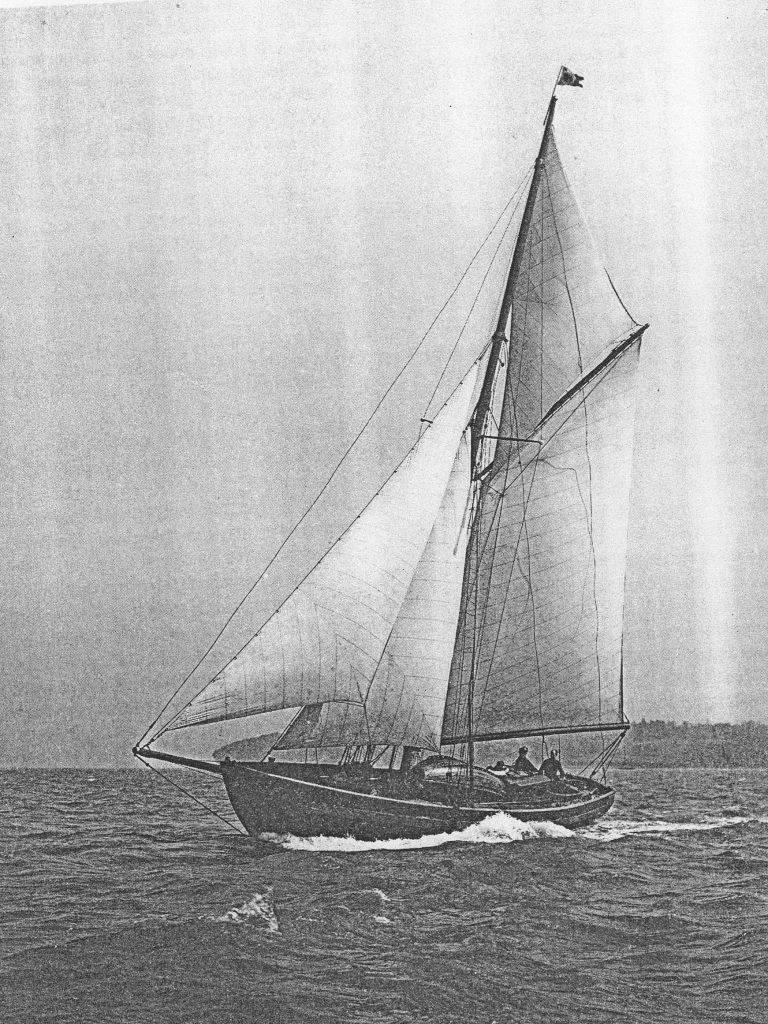
The iconic Dyarchy reaching effortlessly at speed in a fresh breeze.
Was Dyarchy the ultimate design development of the Andrillot line? Would Jack Giles find ways of improving the general type even further after the War? We will try and find some answers for the autumn Newsletter.
____________________
I would like to thank everyone who has contributed to this latest Newsletter, especially Paul Zeusche and Bill Nance in the Pacific NW., and Nick Trethowan in Melbourne. We are planning to conclude the story of Bill’s incredible, single-handed doubling of Cape Horn with Cardinal Vertue next time. We are always keen to hear from fellow Vertue enthusiasts, in order to keep this modest website alive………..so please, keep in touch and keep the stories coming! Fair winds and following seas,
Roger
